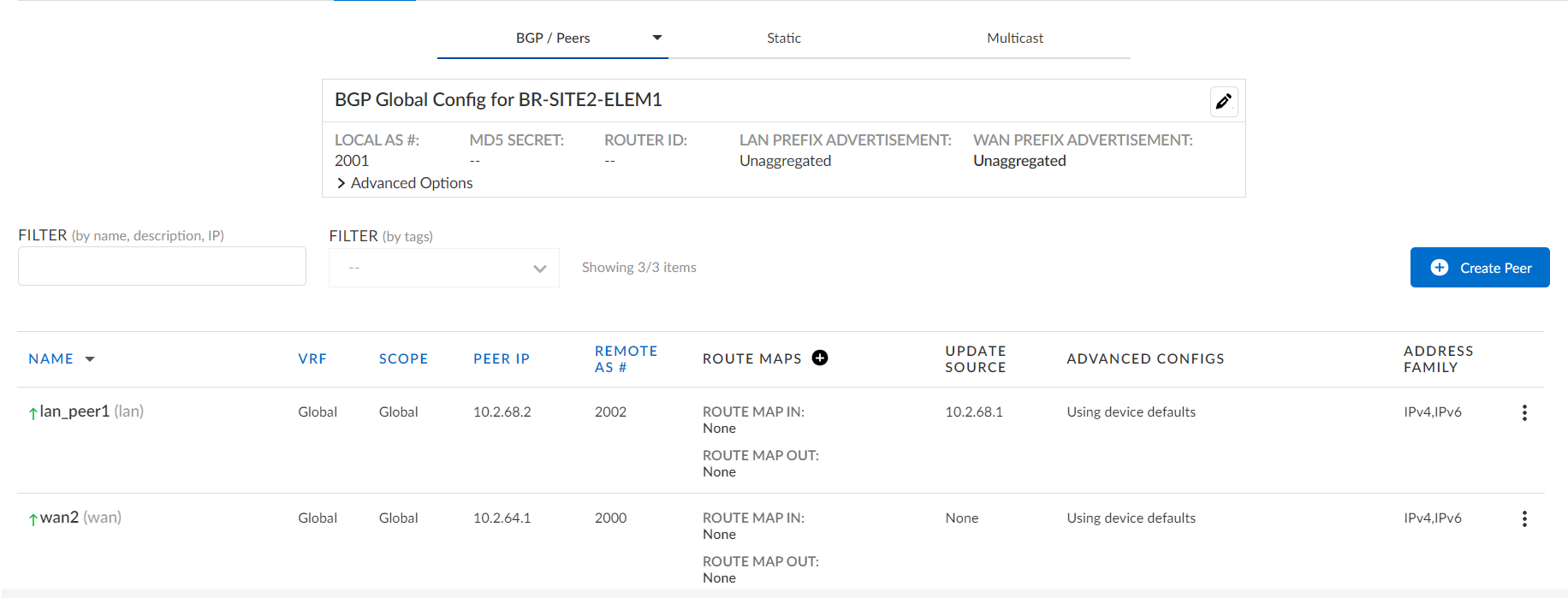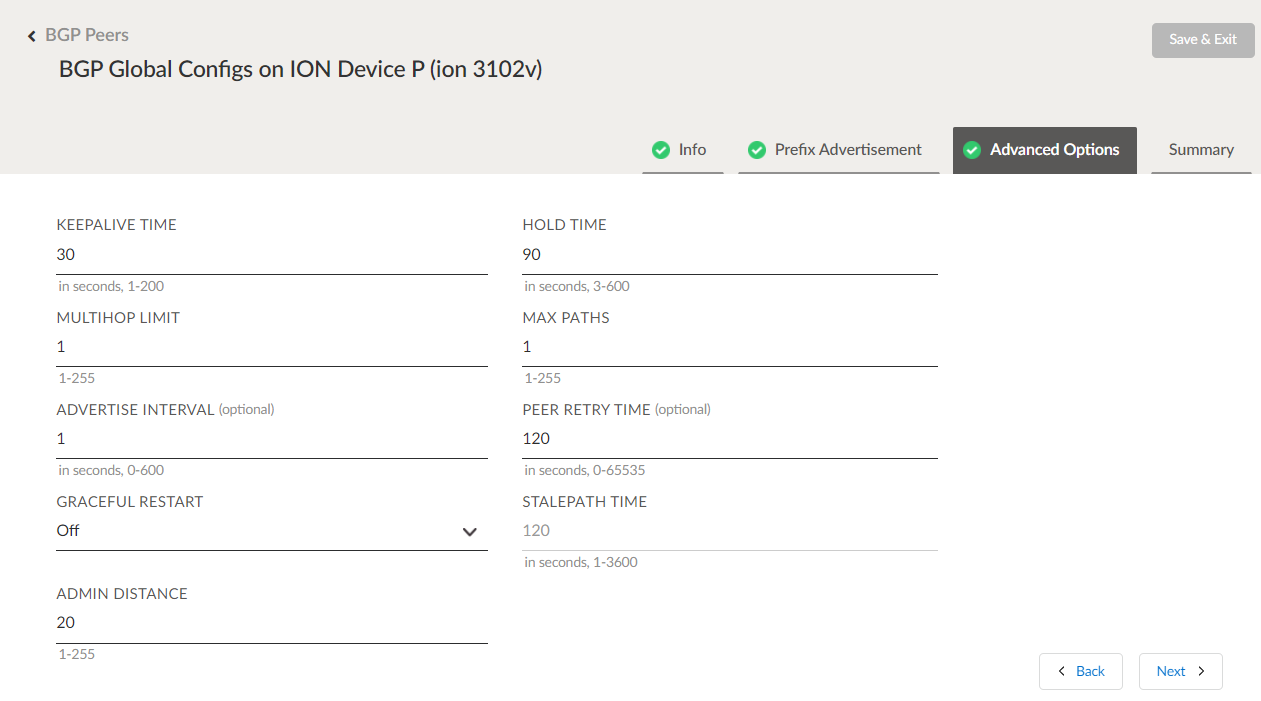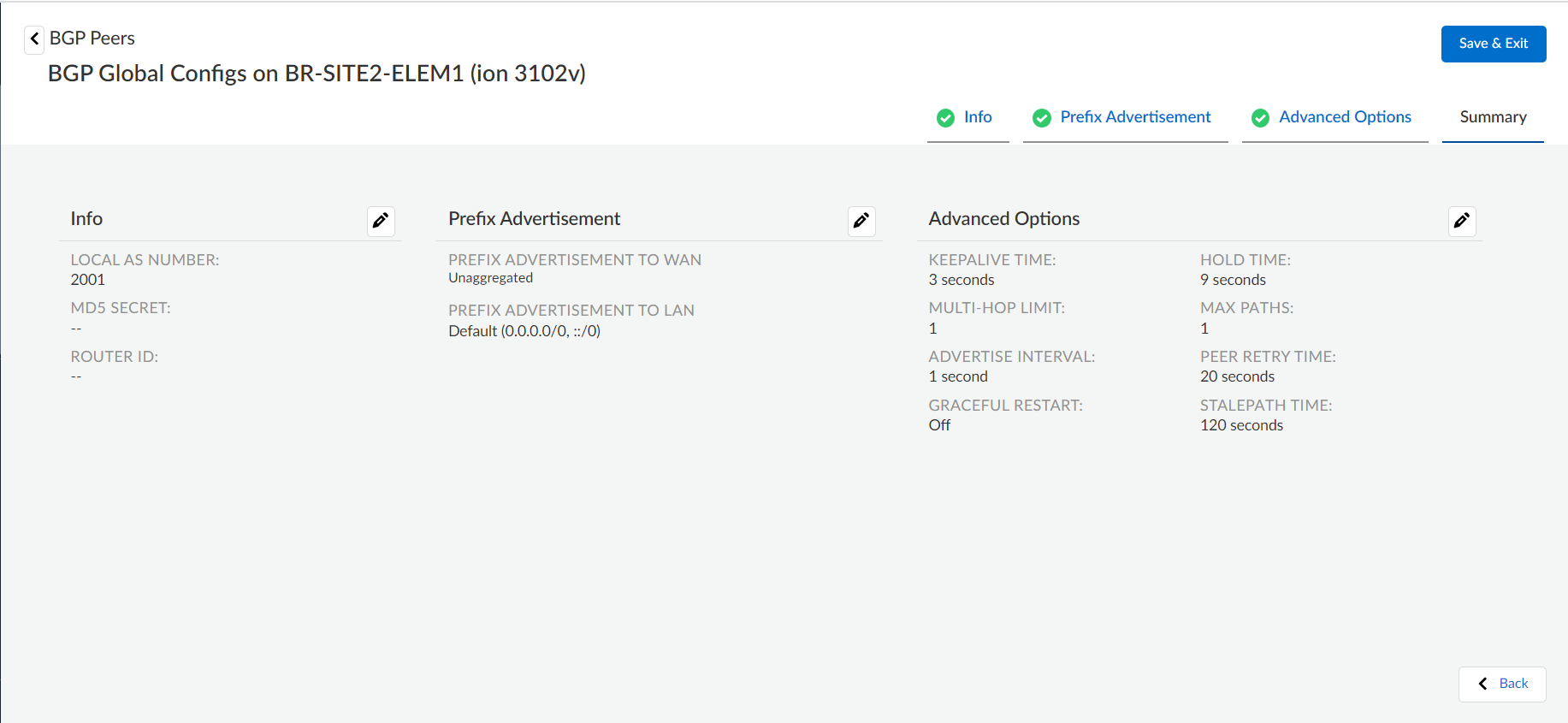Prisma SD-WAN
Configure BGP Global Parameters
Table of Contents
Expand All
|
Collapse All
Prisma SD-WAN Docs
-
-
-
- CloudBlade Integrations
- CloudBlades Integration with Prisma Access
-
-
-
-
- 5.6
- 6.1
- 6.2
- 6.3
- 6.4
- 6.5
- New Features Guide
- On-Premises Controller
- Prisma SD-WAN CloudBlades
- Prisma Access CloudBlade Cloud Managed
- Prisma Access CloudBlade Panorama Managed
Configure BGP Global Parameters
Lets learn about configuring BGP Global Parameters in Prisma SD-WAN. You can configure
the local AS #, optional MD5 secret and router ID, prefix advertisements, and BGP
timers.
| Where Can I Use This? | What Do I Need? |
|---|---|
|
|
Configure BGP global attributes before creating
BGP peers. You can configure the local AS #, optional MD5 secret
and router ID, prefix advertisements, and BGP timers.
- Configure local AS number.
- Select WorkflowsDevicesClaimed DevicesConfigure the deviceRoutingBGP/PeersBGP Global Config for ION deviceEdit.
![]() On the Info tab, enter a Local AS Number between 1 and 4294967295 or as A.B, where A and B are both numbers between 1 and 4294967295.The web interface displays converted values of the AS number entered. If the number entered is an A.B format, the web interface displays the corresponding 32-bit conversion below the entered value. If the number entered is a 32-bit format, the web interface displays the corresponding A.B value below the entered value. The Local AS Number is mandatory.(Optional) Enter an MD5 Secret between 1 and 32 characters.The default value is 0.(Optional) For Router ID, enter the IP address of the ION device.The router ID is an IPv4 address and is the BGP ID of the ION device.(Optional) Configure prefixes to advertise to WAN and LAN.Branch ION devices can learn or advertise prefixes based on the scope configured. A branch ION device does not advertise routes learned on one BGP peer to another BGP peer. The device advertises only LAN networks, static routes, and interface addresses. To advertise any of these prefixes, set the Scope to Global when configuring a BGP peer.
On the Info tab, enter a Local AS Number between 1 and 4294967295 or as A.B, where A and B are both numbers between 1 and 4294967295.The web interface displays converted values of the AS number entered. If the number entered is an A.B format, the web interface displays the corresponding 32-bit conversion below the entered value. If the number entered is a 32-bit format, the web interface displays the corresponding A.B value below the entered value. The Local AS Number is mandatory.(Optional) Enter an MD5 Secret between 1 and 32 characters.The default value is 0.(Optional) For Router ID, enter the IP address of the ION device.The router ID is an IPv4 address and is the BGP ID of the ION device.(Optional) Configure prefixes to advertise to WAN and LAN.Branch ION devices can learn or advertise prefixes based on the scope configured. A branch ION device does not advertise routes learned on one BGP peer to another BGP peer. The device advertises only LAN networks, static routes, and interface addresses. To advertise any of these prefixes, set the Scope to Global when configuring a BGP peer.- Configure Prefix Advertisement to LAN in any of the following ways:
- Default—The device advertises only the default prefix (0.0.0.0/0) and (::/0). This is the default setting for LAN prefix advertisement.
- Unaggregated—The device advertises prefixes as is.
- Auto-Aggregated—The device summarizes the unaggregated prefixes into the largest possible blocks and advertises the prefixes.
The device advertises only Default, Unaggregated or Auto-Aggregated to the LAN.Configure Prefix Advertisement to WAN in any of the following ways:- None (--)—The device does not advertise prefixes. This is the default setting for WAN prefix advertisement.
- Unaggregated—The device advertises prefixes as is.
- Auto-Aggregated—The device summarizes the unaggregated prefixes into the largest possible blocks and advertises the prefixes.
- Manually Aggregated—You can configure a set of prefixes which the device aggregates and advertises.
- Manual Summary Aggregate Only—You can configure a set of prefixes which the device summarizes into the largest possible blocks and advertises these prefixes.
Check the IP Prefix to Advertise to WAN IP Addresses displayed.(Optional) Configure advanced options.![]()
- Keepalive Time—Enter a keep-alive time between 3 - 200 seconds. If you have configured a BGP peer, the device uses the value specified in the BGP peer configuration. If you do not configure a BGP peer or do not specify a value in the BGP global configuration, the keep-alive time defaults to 30 seconds.
- Hold Time—Enter a hold time between 3 - 600 seconds. The hold time needs to be three times greater than the keep-alive time. If you have configured a BGP peer, the device uses the value specified in the BGP peer configuration. If you have not configured a BGP peer, the device uses the value from the BGP global configuration. If you do not configure a BGP peer or do not specify a value in the BGP global configuration, the Hold Time defaults to 90 seconds.
- Multihop Limit—Enter a multi-hop limit between 1 - 255 hops. The default is 1 hop.
- Max Paths—Enter a max path between 1 - 255. The default is 1.
- Advertise Interval— Enter an advertisement interval between 0 - 300 seconds. The default is 1 second.
- Peer Retry Time—Enter a peer retry time between 0 - 65535 seconds. The default is 120 seconds.
- Graceful Restart—By default graceful restart is Off. Select Onto change the default setting.
- StalePath Time—Enter a stalepath time between 1 - 3600 seconds. The default is 120 seconds.
- Admin Distance—Enter a value between 1 - 255. The device sets the default Admin Distance of all learned prefixes to 20. The Admin Distance configured for a static route overrides the Admin Distance configured for a BGP route.
View the Summary to review BGP global configuration and then Save & Exit.![]()



